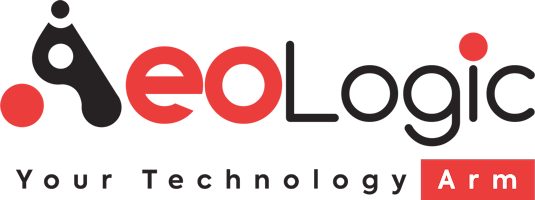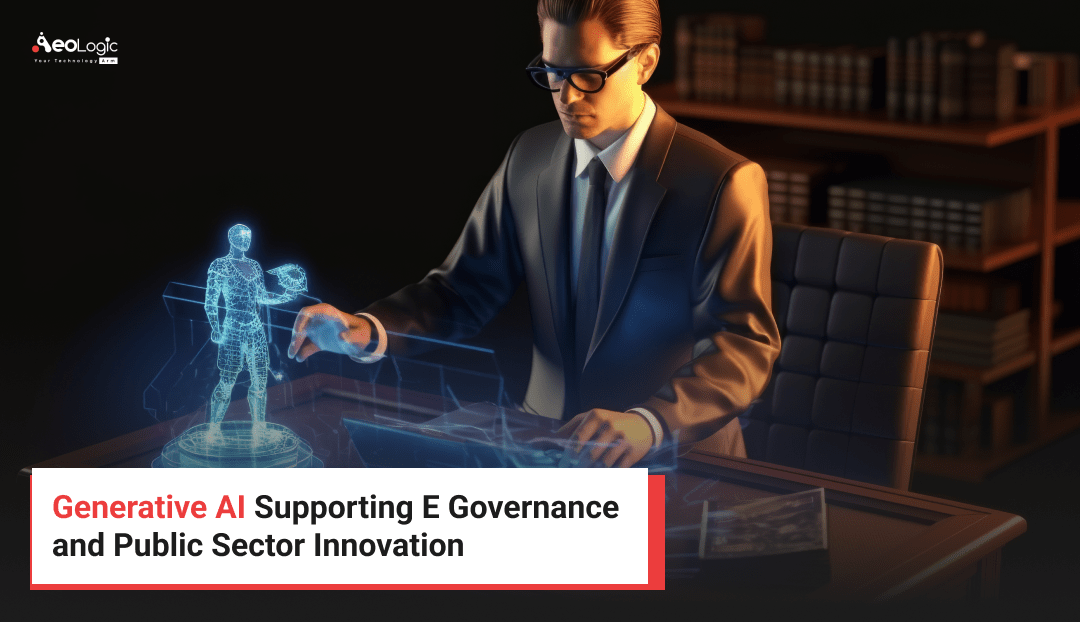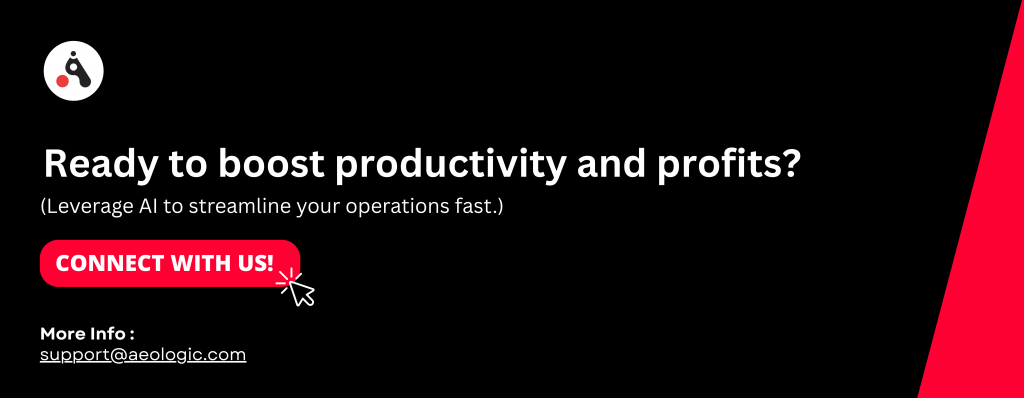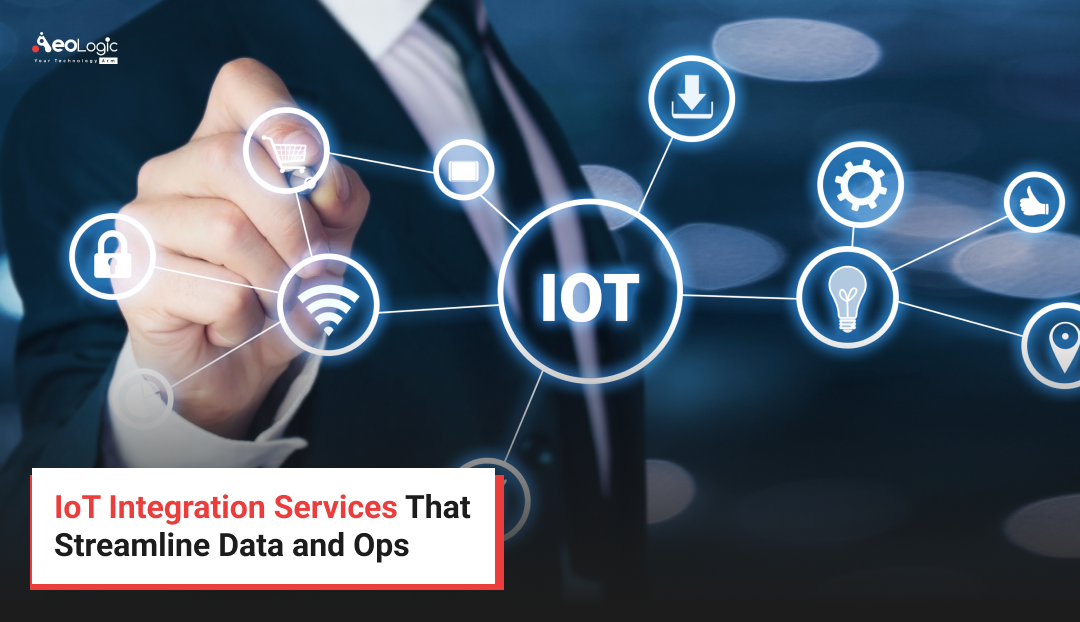The global demand for governments to deliver faster, more efficient and more transparent services is increasing. Citizens want government services to match the speed of technology and also expect personalized communication with fast resolutions to their problems. Most public sector organizations still rely on manual workflows, legacy systems, and operate in resource constrained environments.
These realities slow operations down, hamper decision making and the delivery of service – all of which frustrate citizens and government workers.
The good news is that Generative AI is Revolutionizing Industries. Generative AI in e-Governance is emerging as a valid alternative where these limitations cease to exist. Unlike conventional processes that merely process or analyze data, generative AI can produce new content, complete complex tasks and have substantial input into the decision-making process with very little human initiative.
This technology enables governments to fundamentally rethink how they engage with citizens, to modernize their own internal practices, and to innovate how they deliver public services in volumes and at a pace that was inconceivable before.
The possibilities are endless. Imagine governmental agencies automatically producing reports, drafting policy briefs, or addressing thousands of citizen inquiries in real-time. Generative AI is not just the future; it is already beginning to change the workflow in the public sector and the experience of citizens around the world.
Let’s explore how Generative AI is unlocking new possibilities for governments committed to innovation and better service.
Explore more: Role of Technology in Government and Public Sector
What Is Generative AI in E-Governance and Why Is It Important?
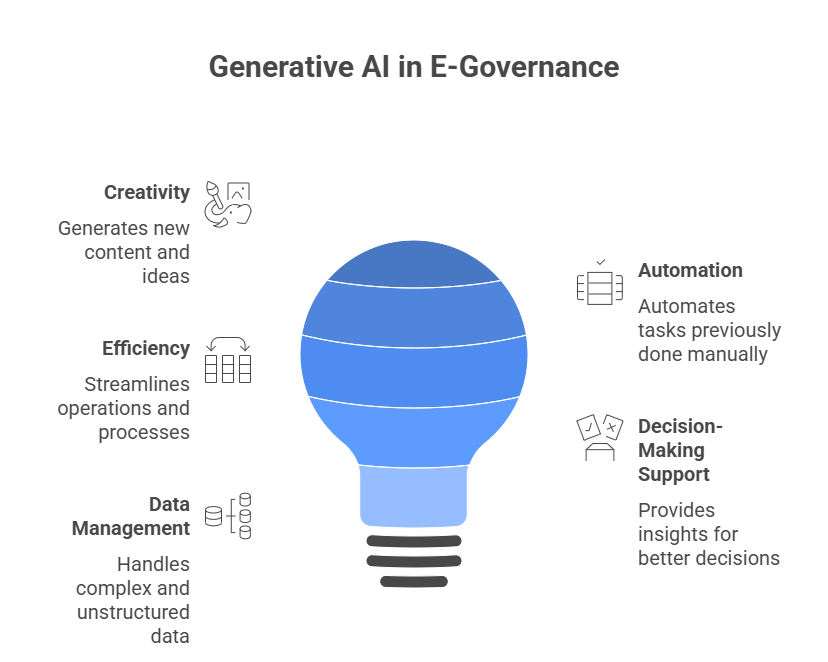
Generative AI falls under the category of Artificial Intelligence. Its distinguishing feature is its creativity and the ability to generate new content or data based on learning patterns from existing information.
Unlike conventional AI, which is designed expressly to analyze data and make predictions or suggestions based upon it, generative artificial intelligence can create written documents, images, code, and simulations, in turn requiring no input from a user. This opens a variety of new potentials for the public sector.
In the e-governance context, generative AI can automate tasks that have previously required full-time manual labor. For example, it can easily draft policy proposals, create communications to citizens, or quickly and accurately compose lengthy reports.
This minimizes government workers’ time, freeing them up to fulfill acting roles that require strategic foresight, practical judgement, critical thinking, and decision-making skills.
Generative AI provides governments with the ability to operate efficiently in an environment that contains complex, unstructured data. Specifically, the nature of public sector work often requires that workers manage legal documents, citizen requests, or policy rulebooks that do not lend themselves to tidy, simplistic databases. Generative AI models can ingest this complicated mixture of documents and create the desired output to best suit the needs of governance.
Ultimately, generative AI offers support to better decision-making by providing suggestions from knowledgeable sources, while automating repetitive work. Generative AI feeds creativity into the routine operations of current AI tools – enhancing the way governments are able to serve their citizens.
Also Read: Top AI and Machine Learning Use Cases Across Industries
How Generative AI is Revolutionizing Public Sector Operations
Generative AI in E-Governance is already changing public sector practices in so many ways, and these examples illustrate how AI is decreasing workloads, increasing accuracy, and improving the citizen experience. 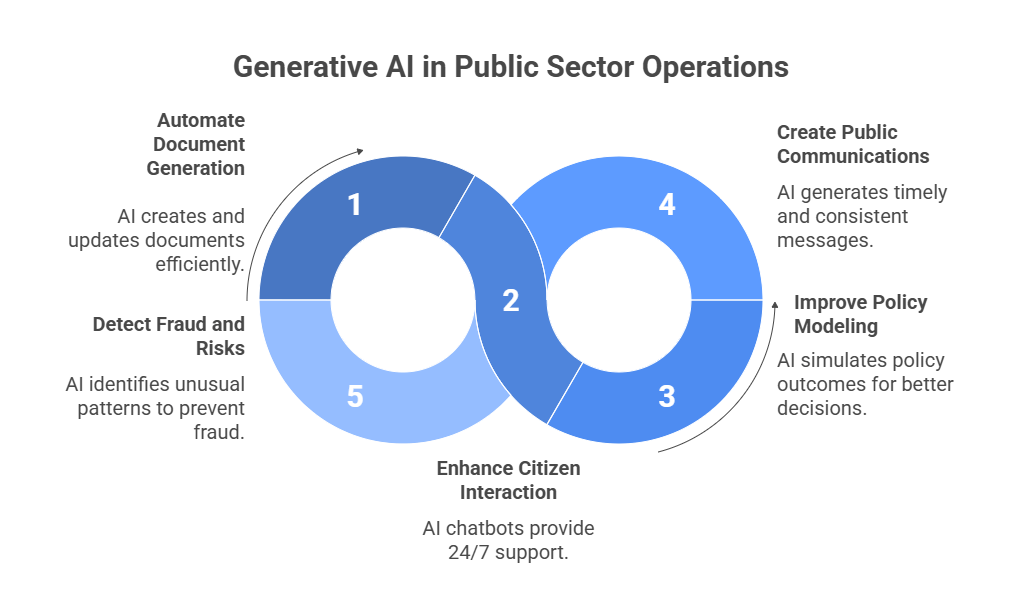
Automated Document Generation
Government agencies deal with an extensive range of documents on a daily basis. Public agencies produce permits, licenses, policies, legal documents, annual reports, and generative AI can create or update any of these documents applying the law and uploading the necessary data and applying templates of pre-determined document templates.
Its application will reduce the workloads involved in manual operation; speed up processing; and decrease error. For instance, a city council could immediately generate budget proposals or project summaries. Automation will enable staff to focus on complex tasks and ensure higher quality outputs.
Citizen Interaction and Support Chatbots
Providing access to citizens’ questions often needs a sizeable support team. Generative AI chatbots and virtual assistants can will respond to citizen’s questions 24/7 without human supervision. The AI will provide answers in a personalized draft response, schedule appointments and find and distribute public service delivery information.
The outcome will be quicker responses, and a happier citizenry, without needing to hire increase staffing.
Policy Modeling and Simulation
Federations will test the policies they plan to implement before they actually implement those policies. Generative AI allows home agencies to create the modeling necessary to simulate a range of scenarios. These modeling simulations utilize historical data and real-time data.
With this kind of insight, policymakers can make better judgments about outcomes, risks, and benefits of a variety of policy scenarios; for example, when evaluating the adoption of a new transport policy, AI can illustrate effects on traffic flow or the environment.
Content Creation for Public Comms
Communicating clear and timely information is important. Generative AI can create a wide range of different communications, such as press releases, newsletters, and social media posts aimed at different audiences in a timely manner. The emergence of generative AI allows agencies to maintain consistency in their messages and free up time.
Fraud Detection and Risk Assessment
Public entities control large financial transactions and manage social programs that support individuals. Generative AI has the potential to recognize patterns that might otherwise be overlooked and used to detect unusual patterns suggesting fraud. Detecting fraud early is important in order to preserve public billions of public funds and build citizen confidence.
Outlining use cases demonstrates that generative AI offers improvements in the work done by traditional forms of government. By utilizing generative AI for or automating repetitive tasks or obvious information, people can spend more time focusing on priorities that are bigger than themselves and deliver more effective public service.
Benefits of Implementing Generative AI Solutions in E-Governance
Generative AI in E-Governance offers numerous opportunities to help governments effectively improve their operation and services to its citizens. For public sector organizations, here are eight benefits to expect:
Improved Efficiency
By automating repetitive processes, including document creation and data analysis, which enables faster progress through workflows, generative AI frees up government staff time for more meaningful decision-making and problem-solving.
Improved Accuracy
Generative AI may eliminate human errors by strictly following patterns and rules to generate content or acquire patterns in data. This will increase the quality of government reports, communications, and policy documents.
Improved Citizen Participation
Generative AI enables AI-based chatbots or quick, personalized messaging to engage quicker and communicate better with citizens, and resolve concerns faster, helping improve government trust with citizen engagement.
Cost Reduction
Using technology to automate the performance of routine work and by gaining speed from work automation, generative AI can significantly reduce operational costs. Public agencies can now do more work, with fewer budgets while still creating or improving the quality of their work each time.
Instantaneous Decision
AI-based simulation and data-generating capabilities provide policymakers access to sophisticated information at such a speed that decision-making is greatly speeded up and more possible with support from data.
Transparency and Accountability
Generative AI allows governments to write obvious and consistent reports and communications, which facilitates sharing information of public interest, and being accountable to public officials.
Scalability
Generative AI implementation solutions can scale up to increasingly larger volumes of work without scaling up staff or costs in a timely way. This can be useful to support governments That must meet citizen demand as circumstances change and expand.
Enabler of Innovation
Using generative AI as a technology for implementation in public sector organizations pushes the boundaries of traditional service delivery to citizens, such as AI-afforded policy development or predictive governance. This way, public sector innovation continues to adapt and reinvent itself.
Together, they demonstrate why many governments are beginning to experiment to implement generative AI solutions for E-Governance. It operates to reify or improve traditional system processes and in addition provides opportunities to explore new possibilities for public sector innovation.
Also Read: How AI/ML Can Change the Public Transportation Industry
Challenges and Considerations When Deploying Generative AI in the Public Sector
Generative AI has advantages. But various governments run into challenges using generative AI effectively and responsibly.
Data Privacy and Security
Public sector organizations maintain sensitive personal information and official government data. Keeping unauthorized personnel from accessing this information is essential. When using generative AI, organizations operating in the public sector must comply with strict data protection legislation. Therefore, generative AI must demonstrate use of encryption, anonymization, and secure access control measures.
Ethical Use and Bias Mitigation
Regrettably, AI can inherit bias present in its training data. For governments, it can lead to unfair treatment of people or make poor policy decisions. Making sure algorithms are communicated transparently is extremely important. Governments should frequently audit their AI to check and address any bias discovered.
Regulatory Compliance
As public-sector organizations must follow multiple layers of complex laws, the responsible and compliant use of AI requires close attention to regulations on the use of data and requirements for transparency and accountability. Moreover, as governments have to keep an eye on newly created legislation on AI strange things may come up in the future.
Integration with legacy systems
Many public-sector organizations are using challenging legacy IT systems. Finding a way to integrate generative AI into any legacy IT systems can be problematic for governments and entities. Potentially, integration may require the legacy systems to be updated with new technology, depending on the cultural and behavioural norms of the organization and the staff. Success depends on strong planning, as well as good communication with employees and the right resources (human and device).
Must Read: How Automation Will Shape the Future of Work in India
Finding the Right AI Solutions Provider: Why Aeologic Stands Out
Selecting the correct partner is crucial for the success of Generative AI being leveraged by E-Governance. Governmental projects are always complex and require AI solutions that are tailored specifically for them. Furthermore, these solutions must be compliant with stringent security, privacy, and regulatory standards.
Because of this, selecting a provider who has expertise in the public sector while providing proven and scalable technology is significant. Aeologic has been recognized as foundational in driving Generative AI solutions for government requirements. They have real AI depth and experience with public sector clients.
This knowledge allows them to build solutions with a focus on transparency, productivity, and adding value to citizens.What makes Aeologic unique is its facilitative teamwork. They bring value by helping government agencies understand their processes, problems, and goals.
This understanding allows them to create AI models that can blend with current processes. Therefore, the technology is expressly aimed at creating an impact from day one.
Security and data privacy are a huge priority for Aeologic. Their AI solutions mute all regulatory, applicable security, and data privacy principles. They also ensure that the necessary safeguards for handling sensitive data are implemented when performing the AI function on the data.
The upside of Aeologic as a provider is that government agencies have access to the latest Generative AI tool. When completing functionality, developers at Aeologic support and continue to have innovative and collaborative ideas and structures designed around increasing childhood administrators and educators capacity using AI.
When governments can move past experimenting with Generative AI, and fully scale the decision with confidence, their action is supported by the experience use cases and practice recommendations from Aeologic as a partner.
The Future of Generative AI in E-Governance
Generative AI is still evolving, and its usefulness in E-Governance will increase. This will potentially change the way in which government delivers services to citizens in the next few years.
One of the more exciting uses is AI-driven policy simulations. Governments will use generative AI to build comprehensive simulations of the impacts of public policy prior to implementing policy decisions. These simulations will provide policymakers with the opportunity to examine several probable interventions in real time. This will increase their ability to anticipate consequences and support a science-based, data-driven decision-making process that minimizes risk.
Further growth will include automated citizen services. Imagine using an AI agent from start to finish to handle complex interactions associated with permits, social benefit applications, and emergencies. This technology will enhance service delivery by automating interactions, substantially reducing wait time, and improving the access and use of governmental services.
The use of continuous learning AI-enabled models will become more prevalent. Continuous learning AI models will adapt and improve their functions based on new data as well as the queries and interactions made with them. This means that systems used by governments will be able to sustain a higher standard of functionality, permitting continuous and incremental advance without constant human participation. It will enable rapid adjustments to accommodate evolving citizen needs, as well as adjusting to unpredictable disruptions.
Lastly, generative AI will provide enhanced interaction and collaboration between governments and citizens. New communication tools will provide a new means for citizens and government to negotiate and participate in the governance process. Governance practices can incorporate public feedback in AI-generated reports and policy development plans, which can enhance accountability and promote community trust.
Also Read: How Technology Help in Government Schemes in India
Final Take
Generative AI in E-Governance has shifted the public sector’s approach to innovation and service delivery. It streamlines repetitive processes, provides enhanced data for decision-making, and improves engagement with the citizenry, leading to improved and more accessible public services.
The range of functionalities from using AI for document creation to modeling policies, generative AI creates new angles for addressing complex public sector challenges.
Partnering with the right AI solutions provider, such as Aeologic, means that these new technologies and tools will be implemented in a secure and effective environment.
With the right partner, government organizations can manage the challenges of data privacy, regulatory compliance requirements, and system integrations to leverage the power of generative AI.
From this point onward, generative AI will continue to bring improvements in terms of responsiveness, transparency, and inclusiveness to governance.
FAQs
How does generative AI impact government transparency?
Generative AI can also generate and produce straightforward, simple summaries of complex government information and decisions, meaning that citizens can more easily understand policies and hold officials accountable, which improves transparency.
Can generative AI help with disaster management and emergency response?
Generative AI can simulate disaster scenarios and produce an action plan for emergency response, using real-time data as it comes in. This assists government agencies in preparing for and responding more successfully to emergency situations.
What role does generative AI play in smart city initiatives?
Generative AI is a technology that can strengthen smart city projects by analyzing complex urban data to improve areas such as traffic flow, energy, and public safety activity, but also uses predictive models to encourage better planning a city for its citizens and distributing resources effectively.
How does generative AI support public health programs?
Generative AI can be used in public health to create personalized health communications, anticipate patterns in outbreak incidence, and generate reports related to healthcare resource allocation. In doing so, generative AI can increase the value and effectiveness of health campaigns and disease control activities.
What skills do government employees need to work effectively with generative AI?
Some of the skills that employees need include digital literacy, data literacy, and an understanding of the ethics of AI. Training should focus on how to interact and collaborate with AI enabled tools, validate its outputs, and remain transparent.

I’m Deepika Pandey, an SEO strategist and content writer with 6+ years of experience. I create SEO-friendly content that drives traffic and engages readers. I combine data insights with creativity to help businesses grow their online presence effectively.
